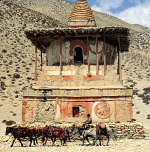
Talk about a breathtaking experience…
You’re on a high and narrow trail, standing with your back pressed tight against the wall of the cliff, while a couple of dozen rider-less horses come thundering past you. Each horse is carrying a full pack running at a hard gallop and sporting a bright feather plume on top of his proud head.
They are headed for the next pass and on to their final destination of Lo Manthang, the capital of the Mustang region. The bottom line here is; everything that comes in to, or goes out of, Upper Mustang must be carried by either man or beast. The good news is, in the entire 780 sq. miles of this remote Nepalese kingdom, you’ll never encounter a traffic jam. There are no roads.
In 1991, the Chinese-Nepalese Boundary treaty, redefined Nepal’s northern borders and made Mustang a part of Nepal. Upper Mustang was, until then, the most inaccessible area in Nepal. Now, even doing the first part of the journey by car and plane, it is still not easy, but it is “do-able”. This trip provides a totally unique experience because this kingdom exists in a time warp.
A trek to this part of Nepal requires serious advance planning and most treks are organized for two or more people. The normal trekking permit for most of the country is $5 US per week, but the permit for Mustang, from the town Kagbeni northwards, is US $500 per week and you must check in advance to see what time frame is needed for the various applications. Permission from the government to trek in this area is normally granted only 21 days in advance and the number of trekkers is limited.
Although, this is not the Nepal of Everest, with snow and ice, the weather has to be a prime consideration. For months, during and following the annual monsoon, the trails can become treacherous and prone to horrendous mudslides. The best weather is usually between March and November; then the days are warm and sunny but the dust and afternoon winds can get tedious.
Most people begin a trek from Kathmandu, and then proceed to Pokhara. The walk to Pokhara could take a week but can be done in about six hours by car. Hiring a car and driver is easily done and should run about $50- $75 US. A guide for the walk to Mustang can also be arranged in Kathmandu with no problem, but be sure to check that your guide is bonded and registered with the government. Costs vary but most guides will ask about $20 US per day, plus food and expenses. The guides speak good English as well as the local dialects.
The Nepalese government is very protective of the fragile environment of this region. Consequently, there are a slew of regulations regarding this trek, which change continually, and may, depending on how far you are going, actually include being accompanied by a government agent, but an astute guide will certainly be aware of the current status.

You’ll usually need a day or two in Pokhara to get things organized but it is a lovely little laid back town on a picturesque lake, that has wonderful clean fresh air and you’ll welcome the change from the crowds and pollution of Kathmandu. Again, your guide will prove invaluable in arranging accommodations and permits.
Now, all you have to do is wait for a flight to Jomsom.
The flight from to Jomson is “iffy” but should be a once a day event. Forget reservations. You just show up at the airport that morning (full of hope and optimism that that there will be room enough for you, your party and your gear), and hope that the weather is good at the Jomson airport. At 8000ft, this airport is closed during part of every day, and sometimes completely for several days because of treacherous high winds. The flight, around $50 US, is approximately an hour of sheer unadulterated terror, in a tiny little (12 seater) plane, but it does save at least five days of walking. We actually had a “stewardess” passing out hard candies and cotton balls to block the engine noise.
You know as soon as you step off the plane and regain your composure, that this will be an experience of a lifetime. You’ll probably find that the airport limo is a horse drawn cart and there might be vendors selling apples on the runway. Nepal’s answer to a “cowboy town”; Jomsom’s “main street” is dirt, has wooden boardwalks and hitching posts and can be surprisingly busy. Lots of trekkers converge here because Jomson is one of the stops on the “Annapurna Circuit”. Perhaps, consider staying a night. A good night’s sleep before starting out and some socializing with fellow travelers could add much to the enjoyment of the trip.
Read Part 2